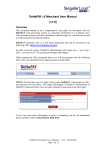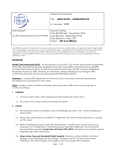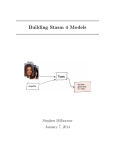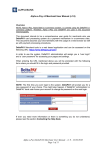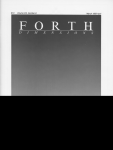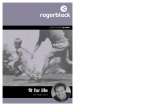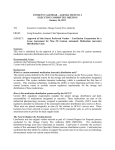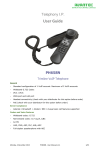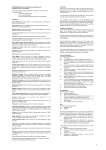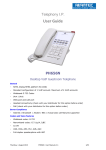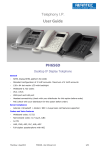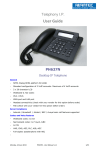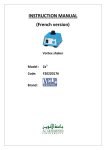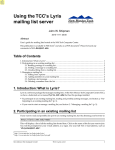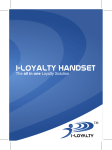Download Governance of Controlled Drugs using Automated
Transcript
T: 0870 4328 250 F: 0870 4328 251 E: [email protected] W: www.avantec.uk.com Governance of Controlled Drugs using Automated Cabinet-based Stock-control Systems An evaluation of ward practice and how Omnicell Point-of-Use Cabinets comply with and improve upon current practice and the legal requirements Rupert Robin Avantec 15.9.07 AVANTEC OMNICELL CD REPORT By Rupert Robin 15.9.07 Section 1 : Aim of this report To examine the current system of ward CD management and the legislative and best-practice frameworks, to see how Omnicell systems can deal with the issues of storage and dispensing of CDs and any other reporting requirements needed. Section 2: Information Sources used in this report 1. Safer Management of Controlled Drugs - A guide to good practice in secondary care (England) DoH May 2007 2. Safer Management of Controlled Drugs (CDs): Changes to Record Keeping Requirements DoH June 2006 3. A guide to good practice in the management of controlled drugs in primary care (England) Second Edition NPC Feb 2007 4. Safer management of controlled drugs : The Government’s response to the Fourth Report of the Shipman Inquiry 5. Statutory Instrument 2001 No. 3998 The Misuse of Drugs Regulations 2001 6. Statutory Instrument 2005 No. 271 The Misuse of Drugs (Amendment) Regulations 2005 7. Statutory Instrument 2005 No. 2864 The Misuse of Drugs (Amendment) Regulations 2005 Section 3: The Law surrounding CD’s with respect to storage, requisitioning, handling, use and destruction The Law is laid down by the Statutory Instruments No 2001/3998 and 2005/271, namely The Misuse of Drugs Regulations and the related Amendment, which essentially followed the final Shipman Report, amongst other forces of change. The Law has been interpreted and guidelines produced for users by both the DoH and the NPC (National Prescribing Centre) as well as various ongoing interim guidelines and updates, issued by the RPS (Royal Pharmaceutical Society), which serve to clarify the practitioners’ legal obligations. Section 4: Comparing Omnicell with the current systems with respect to managing CDs on a Hospital Ward A Using Standard Operating Procedures: Under the current Law, the management of access to CD’s and the recording of their use are essentially two separate activities, the former revolving around storage and key-holding, the latter concerning the act of maintaining a CD register. AVANTEC OMNICELL CD REPORT By Rupert Robin 15.9.07 Under the Law, a department or ward must manage both of these aspects of CD’s according to a written SOP. With an Omnicell system, as will be illustrated below, because the maintenance of records and access control are fully integrated with each other, adherence to that SOP is enforced by the system. Abuse and transgression opportunities are extremely limited. Access to CD’s is no longer a function of simply having a key to the CD cabinet. Maintenance of registers is automatic. B Storage: CD’s must be stored in either an approved cabinet or “otherwise approved by the pharmacy department” (in accordance with the Misuse of Drugs (Safe Custody) Regulations 1973 - SI 1973/ 798). Omnicell cabinets easily conform to the requirements of being locked, immovable, secure storage, which require completely attributable access codes to release the locks, (whilst maintaining an audit of access and access attempts). Omnicell cabinets fail locked in the case of total loss of electrical power, although internal UPS power is provided. Emergency key access is provided, but as this key is only for use in extreme circumstances, it will not be used very often. If the emergency key is used in-appropriately, the cabinets will alarm and record the actions of drawer and compartment ingress. Omnicell cabinets are an improvement on a traditional key-locked cupboard/locker in the following ways: a) Access can be limited to only the drug required at the time of issue, unlike a traditional storage where all CD’s are kept behind a single locked door. The Omnicell cabinet allows each drug to be locked away separately within drawers and drawer compartments, completely apart from other drugs and medicines. b) Identification of the CD is facilitated by the storage strategy described above and the use of preselection before the CD’s are unlocked. The Omnicell cabinet will lead the user to the required CD using ‘guiding light’ technology. c) Space efficiency is greatly improved through the use of drawer storage and the ability to minimize stocks through Omnicell’s automatic reordering systems. d) Security is increased because access is now limited to the actual authorized issuers of the CD’s rather than to whomever happens to be holding the keys at that time. Access is via unique BioID (fingerprint), swipecard or password control. The access is thus monitored and all attempts to remove CD’s are recorded. e) No keys to lose, keep track of, pass from shift to shift, waste time trying to find. AVANTEC OMNICELL CD REPORT By Rupert Robin 15.9.07 C Prescribing: Under the Law, only a registered practitioner can prescribe a CD, or any drug for that matter. This is obviously still the case with the Omnicell system, but now there is a useful extra safeguard added to the prescribing route. The Omnicell system requires the user who is removing the CD from the cabinet to nominate the patient to whom the CD is to be administered. The user must choose a patient from the patient list on the cabinet screen before even selecting the CD to administer. When the patient has been selected, a choice of access is only offered for those CD’s assigned by the Pharmacy system (to which the Omnicell cabinets are linked) as prescribed to that patient. Clearly this is a patient safety improvement over the current locked CD cupboard system, which allows any drug to be removed from the cupboard based solely on the criteria of possession the key. The Omnicell system allows only patient prescribed drugs to be removed D Issuing: Under the current manual locked cupboard type of system, as described above, the user, once in front of an open cupboard, can remove whatever CD’s are desired and leave, choosing to complete the CD register or not. With an Omnicell system, this sequence is reversed and nothing is voluntary. Before the CD is made available to the issuer, the Omnicell system has required the user to enter the following information: Name of user – by unique login to system Time and Date – system generates automatically Transaction reference – automatically generated Patient for which CD is being taken – user must select CD required (from patient specific list) – user must select Dosage required – user must select Only now does the Omnicell system open the specific location where the CD is stored, and monitors its removal. Furthermore, non-preselected and preauthorised opening or attempted opening of other storage locations is recorded. The user is now required to perform a blind count-back of the remaining contents of the storage location for internal stock verification. This information can clearly be used to audit any shortfalls in stock. Now the user must log-out. AVANTEC OMNICELL CD REPORT By Rupert Robin 15.9.07 Unlike the current manual system, where the details of such a transaction are voluntarily recorded manually after the event by the user, under an Omnicell system the transaction is completely specified and approved by the system before it is allowed to happen. The system then confirms the transaction has been carried out as approved before the user is allowed to logout. The whole transaction is recorded automatically reducing the risk of error by omission effectively to zero. E Recording: In the current system, according to the Law, the CD register is filled in after access to the CD has been gained. A bound book or a computer system may be used to record CD usage. The collection of the following data has already been described above. The Omnicell system records: Name of user – by unique login to system Time and Date – system generates automatically Transaction reference – automatically generated Patient for which CD is being taken – user must select CD required (from patient specific list ) – user must select Dosage required – user must select Wastage – calculated from required dose against available doses Quantity in the cabinet – both before and after, with manual countback to verify Because access to the cabinet is only via uniquely attributable access codes, the process of logging is an electronic signature on the CD register. The cabinet can be set to demand the presence of a second authorized person, who must also login when required to during transactions, to act a witness. Witnesses can be assigned to particular CD transactions or to CD transactions by particular users. The wastage calculation feature of the Omnicell system keeps a record of the part use of a dose of a CD if, say, only 60mL of a 100mL vial is to be administered. The expiry date functions of the Omnicell system keeps records of which CD’s are valid for use. If a CD expires, the cabinet will not allow access to it, whilst still maintaining records of it on the system. The Omnicell system automatically maintains a non-voluntary, auditable, fully compliant CD register. F Returning unused and wasted CD’s to storage: Under the current system the Law requires that the CD register be completed for such a transaction, but possession of the CD cupboard key is the only real physical requirement for a AVANTEC OMNICELL CD REPORT By Rupert Robin 15.9.07 return. Using the Omnicell system, a return is handled in the same way as a CD issue. First the user must log in and select the patient against which the return is to be made. The system can be set to allow return to the original storage location or only to a special returns bin. The system can be set to decide whether the return is designated as a CD return or as a CD waste. The system can be set to require a witness or not, CD by CD. Returns can be linked to a previous issue against a particular patient or not (wasted). If the CD is wasted, then the Omnicell system requires the user to enter a reason for the wastage (eg packaging damaged). If the item is to be returned to storage for potential future use, the user must verify the expiry date. The Omnicell system keeps a record of the complete transaction, having collected all the information about it before the CD is allowed to be returned to storage or to the waste/returns bin. As with issuing, the transaction is preapproved and then monitored to see that it is completed before the user is allowed to log off. G Destroying CD’s: CD’s are only allowed to be destroyed by various authorized parties as laid down under the Law. Clearly, the use of an Omnicell system does not change the obligations of the hospital to abide by these constraints. However, the storage of expired and wasted CD’s within a monitored, locked system allows a full audit of the origin of CD’s presented for destruction, and conversely, the system will generate the report detailing which CD’s are eligible for destruction. This enables the relevant parties to be confident that the correct CD’s are being destroyed, to know why they are being destroyed and to be able to confirm the quantities actually being destroyed with reference to a fully auditable automatically generated report. H Stocking and De-stocking ward stores: Under the Law, the transport and handling of CD’s must only be done by various authorized parties, receipts must be signed for by receiving ward staff and the CD register must be maintained to record all stock movements. Requisitions for more CD stock may only be made by approved parties. The Omnicell system operates on a CD Top-Up scheme type of approach. Requisitions for CD’s are generated automatically by the system and issued electronically to the Pharmacy department. The system issues the requisition automatically so no ward staff involvement is required. This has obvious security benefits. The approved pharmacy technicians will physically restock the Omnicell cabinets using their own login codes to access the storage locations and, in a manner similar to that described above for CD removal, will, using preselection and preapproval of transactions, restock the CD’s. The system can be set to require a ward staff witness to the restock so that responsibility for the ward stock remains on AVANTEC OMNICELL CD REPORT By Rupert Robin 15.9.07 the ward, as the Law requires. As the restock is performed and the placing of confirmed quantities of CD’s into their specified storage locations is completed and monitored by the system, the Omnicell system records the actions of the restock and the new stock balances in the electronic CD register. De-stocking is performed in a similar manner, with ward witnessing able to be set as a system requirement to maintain the chain of responsibility. I Stock checks on CD’s: Under the Law, periodic stock checks must be performed and witnessed with the actual balances being recorded in the CD register and discrepancies being noted and investigated. Omnicell systems allow stock checks and discrepancy resolution at any time by authorized users. Discrepancy reports can be computed by patient and by CD for the previous two transactions whilst standing in front of the cabinet, with discrepancy resolution being able to be completed, with witnessing if required, there and then. This allows minor issues to be resolved quickly. Unresolved discrepancies can be further investigated using the full server end reporting and transaction analysis software integral to the Omnicell system. Because each and every access to the CD’s is automatically recorded, the proponents of error and abuse can quickly be tracked through the system and re-trained or disciplined accordingly. Summary The current Law is very clear regarding the persons who are authorized to handle and issue CD’s and requires that a comprehensive register be kept of all CD transactions. Omnicell systems not only comply with the UK legal requirements in letter but surpass the Law in enforcement. Whereas the current standard manual cupboard, key and CD register ward system requires human voluntary adherence to an SOP and the Law, the Omnicell system absolutely requires total compliance to the SOP before a CD can be handled. Furthermore, the details of all transactions are automatically recorded in an electronic CD register. Access to the CD’s is not simply be key possession but is now regulated by uniquely personally identifiable (biometric or otherwise) access codes. An audit trail is available, complete in every aspect. In every area of CD handling, stock management, issuing and returning is improved through the use of an Omnicell system, whilst remaining completely legally compliant. AVANTEC OMNICELL CD REPORT By Rupert Robin 15.9.07 Appendix – Extracts from ‘OmniRx CT Cabinet’ user manual This model is the standard Omnicell Pharmacy system cabinet The reports and extracts below are by no means exhaustive and are designed to illustrate the flexibility and range of the reporting functions and their ability to address the legal and governance issues at stake. Section No. : Title P1.5 - 1.6 : Omnicell Drawers P1.9 - 1.10 : Touch and Go P2.9 - 2.10 : Item Issue – by quantity P2.31 - 2.32 : Waste Partial Dose P2.33 - 2.34 : Waste Meds P2.35 - 2.38 : Return Item P2.53 - 2.54 : Expiration Date Tracking P3.1 - 3.2 : Resolve Discrepancies P5.130 - 5.131: Pharmacy Discrepancy P5.136 - 5.137: Specific Criteria P5.144 - 5.145: Waste and reconciliation : Function : Illustrates level of security and range of options : Control over item withdrawal – ID check : Control over item withdrawal – Med and quantity : Control over partial dose wastage : Control over meds being disposed of : Controlling meds returned to cabinet or return bin : Control of expiry dates : Authorised user can analyse discrepancies : One of many reports to review anomalies : Create your own search – note the CD witnesses : Illustration of another of many possible reports









